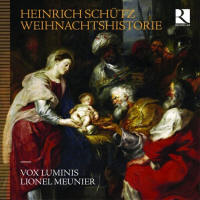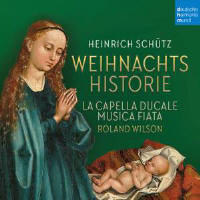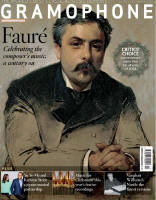| Ricercar | DHM |
 |
 |
| RIC467 | DHM G0100052147055 |
| Code barres / Barcode : 5400439004672 | Code barres / Barcode: G010005214705S |
|
|
|
Texte paru dans: / Appeared in:
|
|
|
|
|
|
Schütz’s Weihnachtshistorie was probably first performed on Christmas Day 1660 at the Dresden court chapel, but when it was published four years later only the music of the Evangelist’s recitatives was printed – although the words were given of the missing choral introduction, eight concerted Intermedien and the final chorus. Its memorandum explained that ‘outside of well-appointed princely chapels, these inventions … will scarcely achieve their necessary effect’, and advertised that the full material requiring at least 11 singers and a panoply of instruments could be purchased from either the Dresden Kreuzkirche organist Alexander Hering or the Leipzig Thomaskantor Sebastian Knüpfer. A few early manuscripts include the music absent from the 1664 publication, albeit with discrepancies and issues that pose editorial conundrums. Vox Luminis and Lionel Meunier model their performance on a copy in the Düben Collection at the University of Uppsala that is customarily the basis for modern editions since its rediscovery at the dawn of the 20th century. Taking a different view, La Capella Ducale and Musica Fiata’s new reconstruction is based on a manuscript among the Berlin Singakademie archive looted by the Soviet army in 1945 and eventually repatriated in 2001; Roland Wilson proposes that the Berlin source is closer to Schütz’s reconsidered final intentions.
Vox Luminis’s Florian Sievers is a compassionate Evangelist and Erika Tandiono delivers the Angel’s appearances to the shepherds and Joseph blissfully (her sentimentality shared by dulcetly honeyed viols). The choral angelic host offers gorgeously serene glory to God, there is calm dignity from the trio of wise men and the bass high priests are accompanied by unforced trombones. Sebastian Myrus’s charismatic smoothness makes Herod’s seemingly innocuous request appear benign, as does the shapely weightlessness of royal trumpets. The Evangelist’s passing mention of the massacre of the innocents could have had a touch more vivid allusiveness to weeping and wailing, but the final chorus has an apt synthesis of lilting joy and assertive splendour.
La Capella Ducale’s marginally fewer voices take an individualistic approach to clear strands within polyphonic textures. Musica Fiata play with vigour, opulence or charm as required. The collective embraces natural consequences of historical instruments, temperament and higher pitch. Tobias Hunger’s quivery Evangelist is an immersive storyteller. Marie Luise Werneburg’s angel relays messages with endearing intimacy and the viols in her Intermedien have ideal sonic separation and clarity. The solo-voice angelic choir exploits stretched harmonic implications and floridity. Chirpy recorders and fruity dulcian are to the fore in the shepherd’s intermedium. Low-voice high priests and darkly sonorous trombones convey wry pomposity. Joachim Höchbauer’s Herod is a blatant villain; Wilson employs high cornettini rather than trumpets, and the keyboardist switches to regal for a piquant effect. The measured final chorus has declamatory lightness of touch. Meunier and Wilson’s dissimilar interpretations of the Weihnachtshistorie are both contextualised alongside about half a dozen other shorter works. The only common ground is Schütz’s Venetian-infused five-choir Magnificat (SWV468). Vox Luminis’s full forces deliver punchy impact in tandem with sweetly elegant solo contributions and adroit concertato instrumentalists. Roland Wilson’s solo favoriti singers and players display rhetorical brightness and Monteverdian harmonic energy; they are excellent at juggling the paradoxical requirements of separation between participants and coherent kaleidoscopic sonorities – there is simultaneously resonant depth and airy lucidity. Vox Luminis’s affinity for Hammerschmidt yields dancelike swagger in the climactic refrain of Alleluia, freuet euch, ihr Christen alle. They throw in Praetorius’s Es ist ein Ros entsprungen with ample instrumental doubling, but best of the extras is Schütz’s O bone Jesu, fili Mariae, an atmospheric devotional masterpiece for seven favoriti voices and choral ripieni matched poignantly by two violins and five viols. La Capella Ducale and Musica Fiata’s all-Schütz programme has an affectionate dramatisation of the Annunciation by countertenor David Erler and soprano Magdalena Podkoscíelna in ‘Sei gegrüsset, Maria’ (Kleine geistliche Konzerte, Book 2, 1639) and the Slaughter of the Innocents is lamented with hints of fragility from countertenors Erler and Alexander Schneider in conjunction with melancholic trombones in ‘Auf dem Gebirge hat man ein Geschrei’ (Geistliche Chormusik, 1648). Musica Fiata and co’s music-making has delineated timbres and personality distinct from Vox Luminis’s entrancing luminosity – admirers of Schütz’s genius will relish both. |
|



